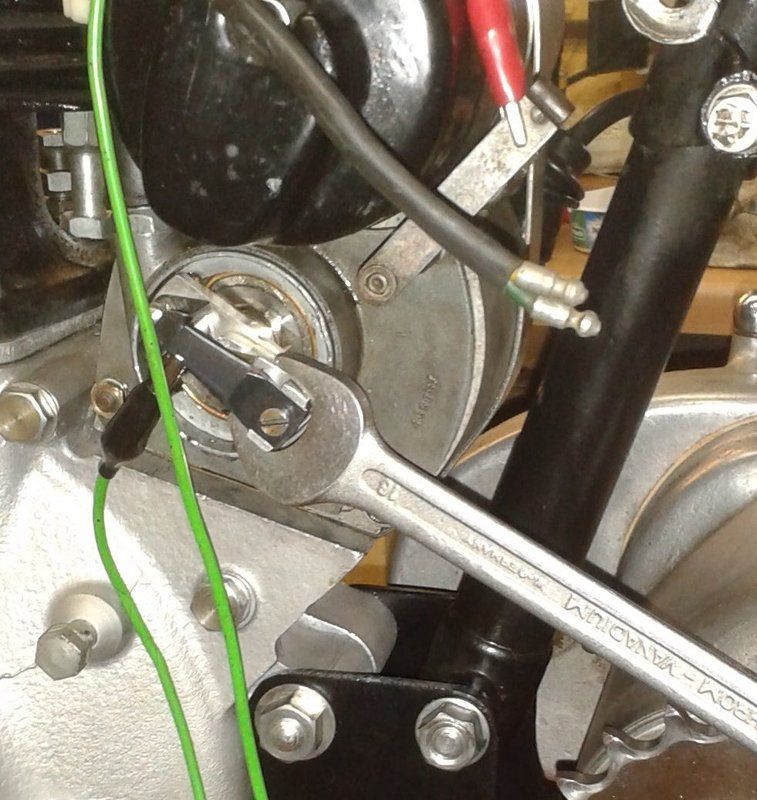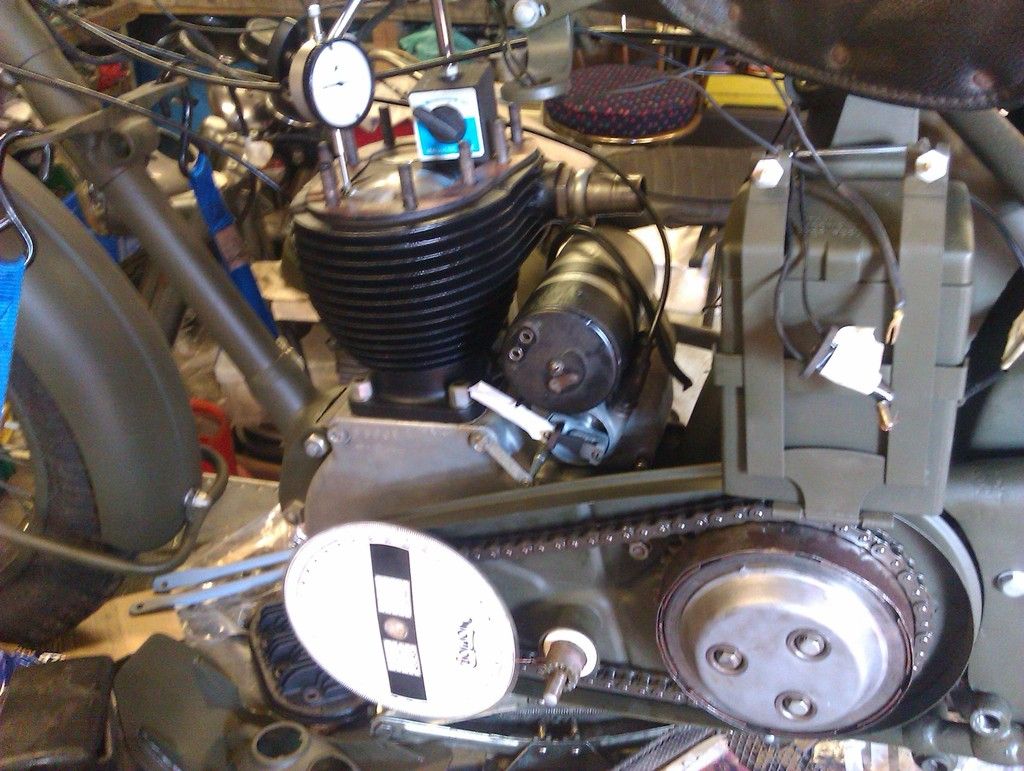When I think how many hours I’ve spent cursing and sweating setting the timing on a magdyno and why I never thought of this before.
The problem for me has always been the pinion slipping on the magneto shaft when tightening it fully. With this 16mm open spanner and another ring spanner on the timing side crank nut (you can lock it in place with a clamp and spacers to the footrest to hold it at the desired position) the whole lot can be effectively immobilized using only TWO hands. At least it worked for me first time and now the timing is 5 thou advanced, which I think I can live with.

My first idea was a metal bar with a threaded hole bolted down across the open barrel. A bolt screwed down to stop the piston at exactly 7/16 BTDC looked great until I realized the engine turns backwards when you tighten the mag pinion nut.

You lot have probably been doing it this way for decades but I don’t care, I’m happy now!


Cheers
Pete
This method is very risky...If too much force is applied by using the points assembly to prevent the mag moving it is very possible the brass end of the armature that the points assembly engages with will be damaged...
In that event a replacement armature will be required
I've seen it done more than once...Personally I wouldn't use that method...Ian
email (option): ian@wright52.plus.com
Point taken, thanks Ian 
Cheers
Pete
If the tapers are in good condition a "tap" on the pinion to seat the tapers when the timing is correct should be enough. The pinion should not move when the nut is tightened. Always remember when doing the timing to turn the engine back to more than 7/16th BTDC then forward to 7/16th to account for the backlash in the timing gears.
I lap in the mag drive gear and armature tapers with some fine grinding paste before fitting the mag to the engine...The closer the fit the less likely they are to move...Ian
email (option): ian@wright52.plus.com
Interesting. I've used the bar bolted across the cylinder face with a central bolt screwed down the requisite number of turns to get the piston travel accurate but I've also had the bike in top gear and some areo elastics on the rear wheel spokes to hold it to prevent the engine from turning as you tighten up.
To stop the pinion from moving on the taper a couple of engineers clamps around the casing and pinion with light pressure are enough. I do like the idea of your spanner to give better control over rotating the armature but not to hold it against spanner torque. I've seen too many sheared keys on contact breaker to want to do that.
Richard
I hold the points block with my hand and gently nip the pinion nut. I then turn the engine over a couple of times and check the position again before bumping the pinion nut up fully.....Then check again. I'm more than happy if I get it right on the 3rd or 4th attempt.
Ron
email (option): ronpier@talk21.com
When the timing is nearly ok you can also fiddle a little by altering the point gap. This can advance or retard the ignition a little. Don't over do it, to much gap or to little gap is not a good idea.
Henk
email (option): ahum@quicknet.nl
Exactly how i do it Ron ...
Not sure about adjusting timing with point-gap, it can be just as hard/fiddly doing it this way.
Particularly if the points are not new/flat.
I’ve tried all the lapping in of spindle and pinion, tapping the pinion onto the taper etc. but it was still taking me a lot more than the 3 or 4 times that Ron needs to get a satisfactory result. Hence the search for other solutions.
This is just an extension of holding the points block still with my hand and I am not exerting what I would consider undue force on the points when tightening the pinion nut (very subjective, I know!). What I do like is that with a long spanner I can accurately position the points at their opening point and hold them there.
Richard’s idea for immobilizing the pinion and drawing it simultaneously onto the taper is interesting.
Having just timed this motor I sincerely hope it will be a long time until I have to do this job again. It is one of those things that really annoys me! (almost as much as recently rebuilding a gearbox, fitting it and the complete primary gubbins then going to fit the rear chain only to find I had somehow forgotten to fit the gearbox sprocket.
 (I guess I only have more of these senior moments to look forward to as time progresses!
(I guess I only have more of these senior moments to look forward to as time progresses!  )
)
Cheers
Pete
The number of attempts I have to make before I set the timing to my satisfaction varies..and the tighter the tolerance I allow myself the more that number is likely to rise..
I was lucky with the last one (Triumph TRW) and got it first time...On other occasions it's taken considerably more attempts...
On this occasion you have managed the job without damage to the mag armature but I assure you, I have repaired a number of mags that have had the armature irreparably damaged by using this method...
It's not for me to tell anyone how to do the job but I'd like to avoid other forum members getting the impression that the method you describe carries no risk, it definitely does and personally I wouldn't recommend its use...Ian
email (option): ian@wright52.plus.com
Cheers
Pete
Ah Pete! When I say "3 or 4 times" That is what I'm more than happy with. Like Ian, I have managed to get it spot on with the first attempt. On the other hand, I remember timing one bike and I was up to over 20 goes. I just could not get it to nip up in the correct place. I was so frustrated, I ignored the call for "dinners Ready" and it was late in the evening before my stubbornness prevailed and I sat down to a luke warm dried up meal

Now my Indian Scout is much simpler. You just slacken the clamp and turn the dizzy
 I've even know guys to adjust them whilst on the move to get the best performance. Although if I tried it I'd probably get a kick off the plug leads and wobble and fall off
I've even know guys to adjust them whilst on the move to get the best performance. Although if I tried it I'd probably get a kick off the plug leads and wobble and fall off Ron
Ron
email (option): ronpier@talk21.com
I'm not really sure what "Spot on" means when timing my 16H or ES2 when you have a mark on a piece of rod through the head or down an angled plug hole(ES2), that isn't easy to see and moves as you move your head, or wherever the rod is on a domed piston. "About right" is where I get it, and with what would seem quite retarded timing figures, I'm happy with slightly advanced, especially with better petrol these days than was originally used. As my 16H has been converted to slack wire advance on the lever, I can retard it slightly while riding along to see if it goes better... It doesn't and seems to like it slightly advanced.
I also fine tunes with the points gap as Henk suggested. Making the gap bigger advances the timing and smaller retards it on these mags, and there is quite a lot of adjustment to get it "Spot on". I haven't noticed a problem having the gap bigger but too small isn't good.
Tapping the sprocket on the shaft should hold it while tightening, but on a bike using a degree disc I find setting the timing a degree more, or less on the disc, depending on what bike and the rotation of the mag  When the nut is tightened on the mag it moves it to the "Spot on" position. You'll soon know which way when doing it.
When the nut is tightened on the mag it moves it to the "Spot on" position. You'll soon know which way when doing it.
email (option): horror@blueyonder.co.uk
['I'm not really sure what "Spot on" means..']
In the case of ignition timing that's an arbitrary figure decided on by the individual, as no specific tolerance is stated by the manufacturer...
Timing figures are stated as a distance before TDC on the older bikes and are expressed as a fractional dimension (ie 7/16" BTDC)...
Applying normal engineering 'standards' a fractional dimension has a tolerance of + or - .015" so that could reasonably regarded as a guide...
I time my bikes with the head off, using a depth micrometer to measure the piston setting and an electrical 'gizmo' to determine the point at which the contact breakers open...
I find this to be accurate and 'repeatable' and I aim to get the setting to within .010" of the laid down figure...
I know many consider this approach to be 'OTT' but I treat the ignition setting laid down by the manufacturer in the same way I do the piston clearance, bush tolerances, plug gap or any other setting or tolerance...
I go for an accurate manufacturers setting/tolerance unless I or someone else has proved by logical experimentation there is a better alternative...
It is entirely possible that the use of modern fuels may mean an alteration to the timing could be beneficial..
However, the potential alteration may not be the same for all engines or even be necessary..
Therefore, in the absence of accurate experimentation results or the presence of any particular problems I think the original setting is the one to be adhered to.....Ian 
email (option): ian@wright52.plus.com
That's the long way to say you do it by the book Ian  But there's no way I'm taking the head off every time I do the timing, especially on my ES2 or Manx
But there's no way I'm taking the head off every time I do the timing, especially on my ES2 or Manx 
email (option): horror@blueyonder.co.uk
['That's the long way to say you do it by the book']..
True enough, but I like to explain my reasoning...It's all food for thought...Ian 
email (option): ian@wright52.plus.com
the last time i adjusted the ignition on my M20 i secured the timing in the middle of the lever on the handle bar, with 2 dots to find the right timing back again, after starting the bike.
I know its is not very accurate, but this timing never is with the tension on the cable and so on.
This allows me to easely change the timing in case the timing slowly changes over the years.

